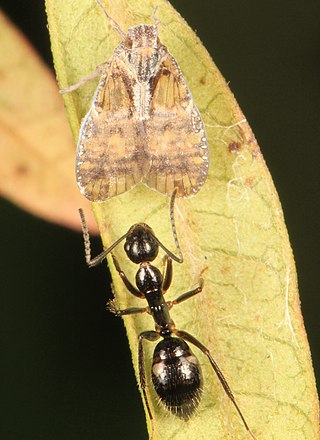
Hoplitis anthocopoides is a species in the family Megachilidae, in the order Hymenoptera . The distribution range of Hoplitis anthocopoides includes Africa, Europe, Northern Asia, and North America.

Formica montana is an ant in the genus Formica in the family Formicidae. A common name for F. montana is "prairie mound ant".

Andrena krigiana is a species in the family Andrenidae, in the order Hymenoptera. The species is known generally as the "dwarf-dandelion andrena". It is found in North America.

Formica fossaceps is a species of ant in the genus Formica, in the family Formicidae. This species is a member of the Formica rufa species group.

Manica hunteri is a species of ant in the family Formicidae.

Triepeolus is a genus of cuckoo bees in the family Apidae. There are at least 140 described species in Triepeolus. The majority of species whose life history is known are kleptoparasitic in the nests of bees in the tribe Eucerini, especially the genera Melissodes and Svastra.

Camponotus sansabeanus is a species of ant in the family Formicidae.

Tetramorium hispidum is a species of ant in the subfamily Myrmicinae. Tetramorium hispidum differs from similar ants in the Myrmicinae subfamily by the structure surrounding the ant's antennal insertions. Short, stubble-like hairs exist on the pronotum and frontal carinae. The antenna of Tetramorium hispidum contains 11 segments.

Aphaenogaster uinta is a species of ant in the family Formicidae.

Camponotus sexguttatus is a species of ant in the family Formicidae.

Camponotus planatus, known generally as the compact carpenter ant or short carpenter ant, is one of three Camponotus species that is polygynous, or has more than one queen. It is a species of ant.

Pheidole metallescens is an ant, a species of higher myrmicine in the family Formicidae.

Trachymyrmex nogalensis is a species of higher myrmicine in the family Formicidae.

Camponotus quercicola is a species of ant in the family Formicidae that is endemic to California and commonly nests in oak trees, as they usually inhabit oak forests.

Myrmica spatulata is a species of ant in the family Formicidae. It is found in the forests of the middle and eastern part of the United States and Ontario in Canada.

Formica microphthalma is a species of ant in the family Formicidae.

Neivamyrmex pilosus is a species of army ant in the family Formicidae.
Brachymyrmex musculus is a species of ant in the family Formicidae.

Myrmelachistini is a tribe of ants in the family Formicidae. There are at least 2 genera and 50 described species in Myrmelachistini.

Pogonomyrmex subdentatus is a species of ant in the family Formicidae.



















